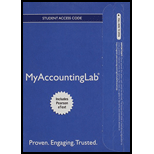
Understanding the alternative treatment of prepaid expenses and unearned revenues
Speedy Pack’n Mail completed the following transactions during 2016:
| Nov. 1 | Paid $5,200 store rent covering the four-month period ending February 28, 2017. |
| 1 | Paid $9,600 insurance covering the six-month period ending April 30, 2017. |
| Dec. 1 | Collected $5,400 cash in advance from customers. The service revenue will be earned $1,800 monthly over the three-month period ending February 28, 2017. |
| 1 | Collected $10,000 cash in advance from customers. The service revenue will be earned $2,000 monthly over the five-month period ending April30, 20 17. |
Requirements
1. Journalize the transactions assuming that Speedy Pack’ n Mail debits an asset account for prepaid expenses and credits a liability account for unearned revenues.
2. Journalize the related
3. Post the journal and adjusting entries to the T-accounts, and show their balances at December 31, 2016. (Ignore the Cash account.)
4. Repeat Requirements 1-3. This time debit an expense account for prepaid expenses and credit a revenue account for unearned revenues.
5. Compare the account balances in Requirements 3 and 4. They should be equal.
Want to see the full answer?
Check out a sample textbook solution
Chapter 3 Solutions
MyLab Accounting with Pearson eText -- Access Card -- for Horngren's Financial & Managerial Accounting, The Financial Chapters (My Accounting Lab)
- Accounting questionarrow_forwardA local credit union negotiates the purchase of a one-year interest rate cap with a cap rate of 4.75 percent with a national bank. The option has a notional principal of 1.5million and costs 2,800. In one year, interest rates are 5.65 percent. The local credit union's net profit, ignoring commissions and taxes, was_.arrow_forwardHelp with problem and accounting questionarrow_forward
 Financial Accounting: The Impact on Decision Make...AccountingISBN:9781305654174Author:Gary A. Porter, Curtis L. NortonPublisher:Cengage LearningPrinciples of Accounting Volume 1AccountingISBN:9781947172685Author:OpenStaxPublisher:OpenStax College
Financial Accounting: The Impact on Decision Make...AccountingISBN:9781305654174Author:Gary A. Porter, Curtis L. NortonPublisher:Cengage LearningPrinciples of Accounting Volume 1AccountingISBN:9781947172685Author:OpenStaxPublisher:OpenStax College Cornerstones of Financial AccountingAccountingISBN:9781337690881Author:Jay Rich, Jeff JonesPublisher:Cengage Learning
Cornerstones of Financial AccountingAccountingISBN:9781337690881Author:Jay Rich, Jeff JonesPublisher:Cengage Learning College Accounting, Chapters 1-27AccountingISBN:9781337794756Author:HEINTZ, James A.Publisher:Cengage Learning,
College Accounting, Chapters 1-27AccountingISBN:9781337794756Author:HEINTZ, James A.Publisher:Cengage Learning,




